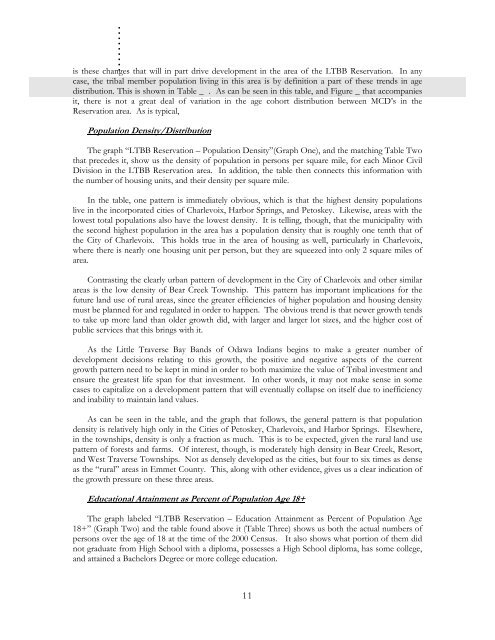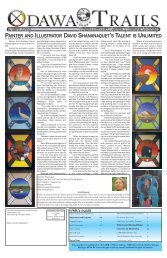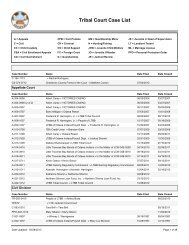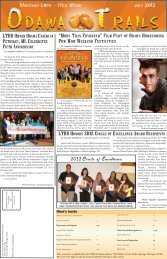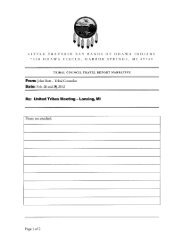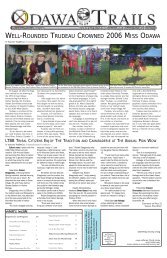LTBB Master Land Use Plan - Little Traverse Bay Bands of Odawa ...
LTBB Master Land Use Plan - Little Traverse Bay Bands of Odawa ...
LTBB Master Land Use Plan - Little Traverse Bay Bands of Odawa ...
You also want an ePaper? Increase the reach of your titles
YUMPU automatically turns print PDFs into web optimized ePapers that Google loves.
.<br />
is these changes that will in part drive development in the area <strong>of</strong> the <strong>LTBB</strong> Reservation. In any<br />
case, the tribal member population living in this area is by definition a part <strong>of</strong> these trends in age<br />
distribution. This is shown in Table _ . As can be seen in this table, and Figure _ that accompanies<br />
it, there is not a great deal <strong>of</strong> variation in the age cohort distribution between MCD’s in the<br />
Reservation area. As is typical,<br />
Population Density/Distribution The graph “<strong>LTBB</strong> Reservation – Population Density”(Graph One), and the matching Table Two<br />
that precedes it, show us the density <strong>of</strong> population in persons per square mile, for each Minor Civil<br />
Division in the <strong>LTBB</strong> Reservation area. In addition, the table then connects this information with<br />
the number <strong>of</strong> housing units, and their density per square mile.<br />
In the table, one pattern is immediately obvious, which is that the highest density populations<br />
live in the incorporated cities <strong>of</strong> Charlevoix, Harbor Springs, and Petoskey. Likewise, areas with the<br />
lowest total populations also have the lowest density. It is telling, though, that the municipality with<br />
the second highest population in the area has a population density that is roughly one tenth that <strong>of</strong><br />
the City <strong>of</strong> Charlevoix. This holds true in the area <strong>of</strong> housing as well, particularly in Charlevoix,<br />
where there is nearly one housing unit per person, but they are squeezed into only 2 square miles <strong>of</strong><br />
area.<br />
Contrasting the clearly urban pattern <strong>of</strong> development in the City <strong>of</strong> Charlevoix and other similar<br />
areas is the low density <strong>of</strong> Bear Creek Township. This pattern has important implications for the<br />
future land use <strong>of</strong> rural areas, since the greater efficiencies <strong>of</strong> higher population and housing density<br />
must be planned for and regulated in order to happen. The obvious trend is that newer growth tends<br />
to take up more land than older growth did, with larger and larger lot sizes, and the higher cost <strong>of</strong><br />
public services that this brings with it.<br />
As the <strong>Little</strong> <strong>Traverse</strong> <strong>Bay</strong> <strong>Bands</strong> <strong>of</strong> <strong>Odawa</strong> Indians begins to make a greater number <strong>of</strong><br />
development decisions relating to this growth, the positive and negative aspects <strong>of</strong> the current<br />
growth pattern need to be kept in mind in order to both maximize the value <strong>of</strong> Tribal investment and<br />
ensure the greatest life span for that investment. In other words, it may not make sense in some<br />
cases to capitalize on a development pattern that will eventually collapse on itself due to inefficiency<br />
and inability to maintain land values.<br />
As can be seen in the table, and the graph that follows, the general pattern is that population<br />
density is relatively high only in the Cities <strong>of</strong> Petoskey, Charlevoix, and Harbor Springs. Elsewhere,<br />
in the townships, density is only a fraction as much. This is to be expected, given the rural land use<br />
pattern <strong>of</strong> forests and farms. Of interest, though, is moderately high density in Bear Creek, Resort,<br />
and West <strong>Traverse</strong> Townships. Not as densely developed as the cities, but four to six times as dense<br />
as the “rural” areas in Emmet County. This, along with other evidence, gives us a clear indication <strong>of</strong><br />
the growth pressure on these three areas.<br />
Educational Attainment as Percent <strong>of</strong> Population Age 18+<br />
The graph labeled “<strong>LTBB</strong> Reservation – Education Attainment as Percent <strong>of</strong> Population Age<br />
18+” (Graph Two) and the table found above it (Table Three) shows us both the actual numbers <strong>of</strong><br />
persons over the age <strong>of</strong> 18 at the time <strong>of</strong> the 2000 Census. It also shows what portion <strong>of</strong> them did<br />
not graduate from High School with a diploma, possesses a High School diploma, has some college,<br />
and attained a Bachelors Degree or more college education.<br />
11


